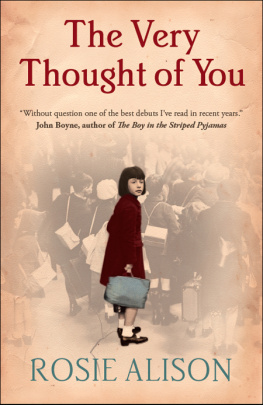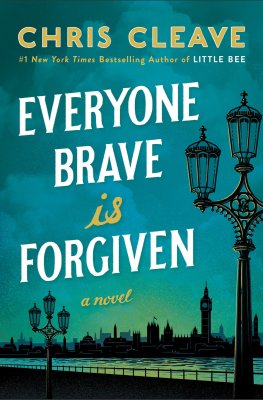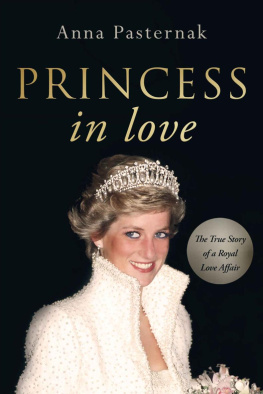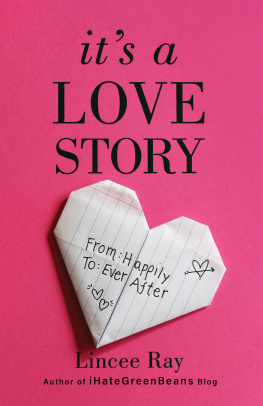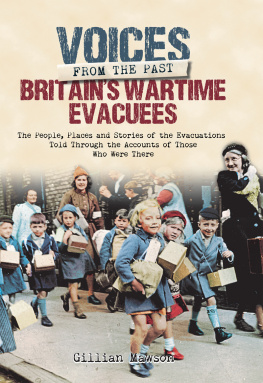THE VERY THOUGHT OF YOU
ALMA BOOKS LTD
London House
243253 Lower Mortlake Road
Richmond
Surrey TW9 2LL
United Kingdom
www.almabooks.com
First published in UK by Alma Books Limited in 2009 (Reprinted June 2009)
This mass-market edition first publshed 2010
Copyright Rosie Alison, 2009
Epigraph: Late Fragment, from All of Us by Raymond Carver, published by
Harvill Press. Reprinted by permission of the Random House Group Ltd.
Oh, Lady Be Good, words and music by George Gershwin and Ira Gershwin
1924 (Renewed) WB Music Corp. (ASCAP)
The Very Thought of You, words and music by Ray Noble 1934 Campbell
Connelly & Co Ltd. All Rights Reserved, Redwood Music Ltd (Carlin) London
NW1 8DB for the Commonwealth of Nations, Eire, South Africa and Spain
The Way You Look Tonight, words by Dorothy Fields, music by Jerome
Kern 1936 T.B. Harms & Company Incorporated, USA. Universal Music
Publishing Limited (50%). Used by Permission of Music Sales Limited and
Shapiro, Bernstein & Co., Inc. o/b/o Aldi Music.
All Rights Reserved. International Copyright Secured.
somewhere i have never travelled, gladly beyond is reprinted from COMPLETE
POEMS 1904-1962, by E.E. Cummings, edited by George J. Firmage, by
permission of W.W. Norton & Company. Copyright 1991 by the Trustees for
the E.E. Cummings Trust and George James Firmage.
Rosie Alison asserts her moral right to be identified as the author of this work
in accordance with the Copyright, Designs and Patents Act 1988
This is a work of fiction. Names, characters, places and incidents either
are the product of the authors imagination or are used fictitiously, and any
resemblance to actual persons, living or dead, business establishments, events
or locales is entirely coincidental.
Printed in Great Britain by CPI Cox & Wyman Ltd, Reading, Berkshire
ISBN: 978-1-84688-100-8
eBook ISBN: 978-1-84688-116-9
All rights reserved. No part of this publication may be reproduced, stored in or
introduced into a retrieval system, or transmitted, in any form or by any means
(electronic, mechanical, photocopying, recording or otherwise), without the
prior written permission of the publisher.
This book is sold subject to the condition that it shall not be resold, lent, hired
out or otherwise circulated without the express prior consent of the publisher.
THE VERY THOUGHT
OF YOU
R OSIE A LISON

For my daughter Lucy
And did you get what
you wanted from this life, even so?
I did.
And what did you want?
To call myself beloved, to feel myself
beloved on the earth.
Raymond Carver, Late Fragment
Contents
Prologue
May 1964
My dearest,
Of all the many people we meet in a lifetime, it is strange that so many of us find ourselves in thrall to one particular person. Once that face is seen, an involuntary heartache sets in for which there is no cure. All the wonder of this world finds shape in that one person, and thereafter there is no reprieve, because this kind of love does not end, or not until death
From Baxters Guide to the Historic
Houses of England (2007)
Any visitor travelling north from York will pass through a flat vale of farmland before rising steeply onto the wide upland plateau of the North Yorkshire Moors. Here is some of the wildest and loveliest land in England, where high rolling moorland appears to reach the horizon on every side, before subsiding into voluptuous wooded valleys.
These moors are remote and empty, randomly scattered with silent sheep and half-covered tracks. It is unfenced land of many moods. In February the place is barren and lunar, prompting inward reflection. But late in August this wilderness surges into bloom, igniting a purple haze of heather which sweeps across the moors as if released to the air. This vivid wash of colour mingles with the oaks and ashes of the valleys below, where the soft limestone land flows with numerous streams and secret springs.
It is hallowed territory, graced with many medieval monasteries, all now picturesque ruins open to the sky. Rievaulx, Byland, Jervaulx, Whitby, Fountains these are some of the better-known abbeys in these parts, and their presence testifies to the fertile promise of the land. The early monastic settlers cleared these valleys for farming, and left behind a patchwork of fields marked by many miles of drystone walls.
Nearly two centuries later, long after the monasteries had been dissolved, the Georgian gentry built several fine estates in the valleys bordering these moors. Hovingham Hall, Duncombe Park, Castle Howard and others. Trees were cleared for new vistas, grass terraces levelled, and streams diverted into ornamental lakes all to clarify and enhance the natural patterns of the land, as was the eighteenth-century custom.
One of the finest of these houses, if not necessarily the largest, is Ashton Park. This remote house stands on the edge of the moors, perched high above the steep Rye Valley and theatrically isolated in its wide park. For some years now, the house and its gardens have been open to the public. At one corner of an isolated village stand the ornate iron gates, and the park lodge where visitors buy their tickets. Beyond, a long white drive leads through a rising sweep of parkland, dotted with sheep and the occasional tree. It is a tranquil park, silent and still, with a wide reach of sky.
Turning to the left, the visitor sees at last the great house itself, a Palladian mansion of honeyed stone, balanced on either side with curved wings. Topping the forecourt gates are two stone figures rearing up on hind legs, a lion and a unicorn, each gazing fiercely at the other as if sworn to secrecy.
The house appears a touch doleful in its solitary grandeur, an impression which only intensifies when one enters the imposing but empty Marble Hall, with its scattering of statues on plinths. Red rope cordons mark the start of a house tour through reception rooms dressed like stage sets, leading this visitor to wonder how the house could have dwindled into quite such a counterfeit version of its past.
The guide brochure explains that when the last Ashton died, in 1979, there remained only a distant cousin in South Africa. Mrs Sandra De Groot, wife of a prominent manufacturer, appears to have been so daunted by her inheritance that she agreed to hand Ashton Park over to the National Trust in lieu of drastic death duties. But not before the estate was stripped of its remaining farmland and other valuable assets. Two Rubens paintings were sold, alongside a Claude Lorraine, a Salvator Rosa and a pair of Constables. Soon after, her lawyers organized a sweeping sale of the house contents a multitude of Ashton treasures accumulated over three hundred years, all recorded without sentiment in a stapled white inventory.
One pair of carved George IV giltwood armchairs, marked; one Regency rosewood and brass-inlaid breakfast table; one nineteenth-century ormolu centrepiece
Antique dealers from far and wide still reminisce about the Ashton auction of 1980, the final rite of a house in decline. It is said that a queue of removal vans clogged the drive for days afterwards.
Mrs De Groot was apparently not without family feeling, because she donated a number of display cabinets to the National Trust, together with the house library and many family portraits and papers. In a curious detail, the brochure mentions that the exquisite lacquered cigarette cases of the late Elizabeth Ashton were sent to the Victoria and Albert Museum.
Next page
